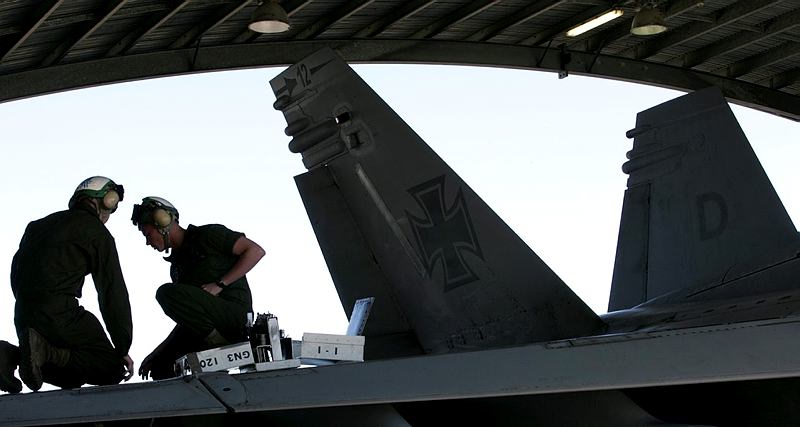Too much of a good thing?
Posted By Andrew Davies on October 27, 2015 @ 06:00
I had the chance last week to give a short presentation at the ADF’s Joint Warfare Conference. As a professional contrarian, I started my contribution with this:
‘Jointness is overrated. It’s a concept more valued by military professionals than it’s likely to be by Australian governments deliberating military action. In particular, the joint amphibious capability we’re going to put a lot of effort (and therefore opportunity cost) into developing probably isn’t going to pay dividends commensurate with the cost. Achieving interoperability with allies and partners is a better use of scarce ADF resources than joining up the individual services within it.’
When I say that jointness is overrated, that doesn’t mean that I think it’s not helpful or desirable. Obviously it’s preferable for the ADF’s various force elements to be able to communicate and coordinate their actions. There are low levels of jointness that are routinely useful: reliable communications between force elements and joint logistics to support a regional peacekeeping operation with a deployed joint headquarters, for example.
But in more contested environments jointness involves complex system integration and data fusion to support shared real time situational awareness and activities like cooperative targeting. And that’s costly. Like most military systems, jointness satisfies Augustine’s 7th law [2]: ‘the last 10% of the performance sought generates one-third of the cost and two-thirds of the problems’.
So we have to think about the utility of those last few percentage points. The ADF certainly hasn’t needed that level of jointness recently. At the moment, the RAAF’s operating in a coalition air campaign, Navy’s off doing naval things off the coast of Africa and elsewhere, and Army has small deployments in a number of places. In none of those is the ADF delivering a joint effect, apart perhaps from the Army’s occasional use of air transport. We have to go back to the Timor operation in 1999 to see the ADF’s three services operating closely together, and even then it was in relatively benign circumstances. (To be fair, we weren’t sure at the time that things mightn’t heat up.)
Yet there’s aspiration to do much more, especially in amphibious operations. The 2009 and 2013 defence white papers said this:
‘The ADF would seek to undertake operations against an adversary’s bases and forces in transit, as far from Australia as possible. This might involve using strike capabilities and the sustained projection of power by joint task forces, including amphibious operations in some circumstances.’
Both documents went on to explain that the aim is to produce an amphibious capability suitable for employment across the spectrum of operational activities— from humanitarian and disaster relief through to power projection. That’s a huge span, and the upper end would require support from the ADF’s most capable combat platforms—fast jets overhead and air warfare destroyers, sea control from surface combatants and submarines, and extensive intelligence support. In short, most of the ADF’s capability would have to be mobilised to support amphibious operations in contested spaces.
I pick on amphibious operations [3] because they require the most jointness. But at the high end I think they’re the sort of operations least suited to a capable but small force like the ADF. Lower down the capability scale it’s easier to imagine a circumstance in which a joint ADF capability would be useful. An evacuation of people at risk in the event of a breakdown of law and order or violent suppression by local authorities in one of the more populous regional nations would be challenging. Being able to move decisively to points of entry and to provide land and air mobility within the nation would be important.
So really I’m talking a matter of degree. If jointness was free I’d want as much as we could get. But it’s not free, and the higher we set the bar the more it costs. We need enough jointness to do the evacuation described above or replicate a Timor operation—the sorts of things we have to be able to do on our own. Anything harder is likely to see us operating with allies and partners rather than standing alone, so I’d argue that interoperability trumps jointness at a certain point.
If we can get interoperability and jointness so much the better. But if we have to choose one, interoperability should get the nod, and in many circumstances would give governments more policy options. I suspect a National Security Committee would rather spend an extra dollar on more interoperability between the ADF and the US, while Defence would probably opt for more jointness. In Iraq and Syria the RAAF has just demonstrated how seamlessly it can work with even the most sophisticated allies. It’s probably fair to say that the RAAF finds it easier to work with the USAF than with the Australian Army. And given what the ADF is likely to be asked to do in the foreseeable future, that’s not necessarily a bad thing.
Article printed from The Strategist: https://www.aspistrategist.org.au
URL to article: https://www.aspistrategist.org.au/too-much-of-a-good-thing/
URLs in this post:
[1] Image: http://www.aspistrategist.org.au/wp-content/uploads/2015/10/20070628raaf8164101_154.jpg
[2] Augustine’s 7th law: http://www.aspistrategist.org.au/aspi-recommends-augustines-laws-2/
[3] I pick on amphibious operations: http://www.aspistrategist.org.au/amphibiosity-how-much-is-enough/
Click here to print.
